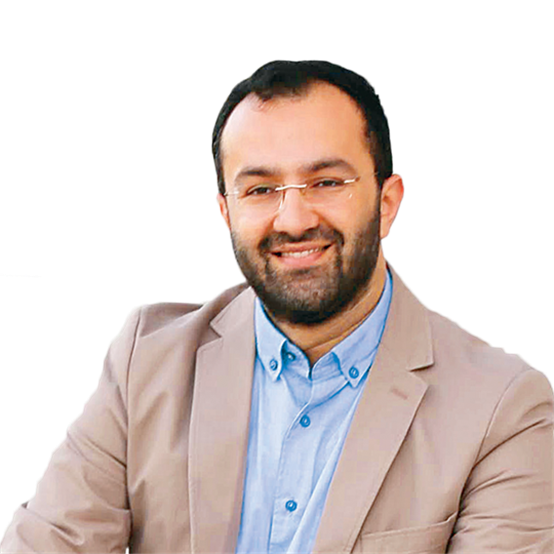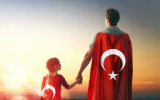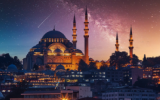
- 05.07.2025, Saturday
- 05:29
From Bosnia to Gaza...
14:3822/11/2023, Wednesday
Next article
Taha Kılınç
Taha Kılınç was born in 1980 in Turkey’s southern Mersin. He graduated from Istanbul University’s faculty of theology. Kılınç worked for the Sabah newspaper between the years 2011 and 2016. The Middle East and the Islamic world are both Kilinc's specialties and where he feels most at peace. He has 16 published books, and is married with three children.

Taking advantage of the mid-term break, I took my daughter Meryem (13) and her two friends (Hanne Meryem and Betül Meryem) to Bosnia, and I repeated this suggestion to them several times. During our three-day trip from November 17th to 19th, they indeed took extensive notes, documenting everything I talked about and every detail that caught their attention. I specifically wanted Meryem and her friends to get to know Bosnia closely because this place has become one of the most refined in all aspects
Taking advantage of the mid-term break, I took my daughter Meryem (13) and her two friends (Hanne Meryem and Betül Meryem) to Bosnia, and I repeated this suggestion to them several times. During our three-day trip from November 17th to 19th, they indeed took extensive notes, documenting everything I talked about and every detail that caught their attention.
I specifically wanted Meryem and her friends to get to know Bosnia closely because this place has become one of the most refined in all aspects in the Balkans. It was possible to succinctly narrate the story written by the Ottoman Empire in Rumelia, what has survived from the past to the present, the glittering traces left by Aliya, the atrocities in the Bosnian War, the costs of being a Muslim, and much more.
On Friday afternoon, under pouring rain, we arrived in Sarajevo and settled into our house in the Alifakovac neighborhood, then started strolling through the Bascarsija. We talked extensively about Gazi Husrev Bey (1480-1541), who left an indelible mark on Sarajevo and his works. Through historical structures, we focused on how a "Muslim city" could be shaped. While crossing Ferhadiye Street, the sudden change in architecture and the charming buildings with tiled roofs, replacing those on the western side of Sarajevo, caught the attention of the girls. The clear distinction between the "Muslim quarter" and the "Christian quarter," I believe, will stay in their memories for a lifetime.
Early Saturday morning, we visited the Kovači Martyrs' Cemetery and paid a visit to Aliya's grave. I explained to the girls about Aliya, what he meant for Bosnia, the stories of those lying in martyrdom, and the Bosnian War. Later, we left Sarajevo and descended to the charming Ottoman town of Počitelj, built as a fortress on the former Ottoman-Venetian border. Počitelj, both in terms of its location and architectural beauty, was impressive. From there, we extended our journey to the magnificent Blagaj Tekke, located where the Buna River originates. Here, we discussed the role of sufism and dervishes in the Ottoman's holding in the Balkans.
Mostar became one of the most striking stops of our entire trip. After performing our noon and afternoon prayers in the complex built by Karagöz Mehmed Bey, the brother of Grand Vizier Rüstem Pasha, dating back to 1558, we descended to the banks of the Neretva, which was rising due to the influence of the rains. While taking shelter under the splendid shadow of the Mostar Bridge, I showed the girls images of the bridge's sudden collapse on November 9, 1993, under the artillery fire of the Croats. Their innocent question, "But why? What did they want from the bridge?" had a clear answer: Enemies wanted to destroy anything that reminded us, and this enmity is not over today.
When we returned to Sarajevo in the evening, a surprise awaited us in front of the Bascarsija Sebil. Many people from different nations, holding Palestinian flags, were protesting against the genocide Israel was conducting in Gaza. Meryem and her friends immediately joined the demonstration, grabbing the edge of one of the big flags and chanting slogans. The Gaza issue was already quite active in Bosnia. Everywhere we went and almost every shop we entered greeted us with Palestinian flags. This was very normal because Bosniaks would certainly be one of the nations who best understand what "genocide" means. Therefore, the greetings sent from Bosnia to Gaza were very sincere and genuine.
On the last day of our trip, we climbed to the Hambina Carina Cemetery on one of the hills overlooking Sarajevo and visited the grave of Mehmed Hancic Hoca (1906-1944). He was the man who raised Aliya. While struggling to keep Bosnia as an Islamic land, he was killed by terrorist Islamophobes disguised as doctors when he was only 38 years old. His story saddened all of us.
After greeting Hancic, we headed to Srebrenica. At the Potocari Martyrs' Cemetery, reached after a long and arduous journey, there was a tranquility and silence that reminded one of the Hereafter. We examined the list of names of the martyrs killed by the Serbs in the summer of 1995 in great detail. Many people from the same family... of all ages, many victims... Their only "crime" was being Muslim... I told the girls, "There are three nations in the world with very deep hostility towards Muslims: the Serbs in the Balkans, Zionist Jews in the Middle East, and Hindus in Asia. Whatever happened in Srebrenica is currently happening in Gaza and much more."
When our trip, which was accompanied by dear Ismail Furkan Yurdakul, who lives in Sarajevo due to his job, came to an end, I asked Meryem, "How did you find Bosnia?" Their answers were exactly what I wanted to hear: It was a country that felt very close, warm, and familiar to them."
#Bosnia
#Gaza
#Muslims
#Islam
#Sarajevo
Comments
Hello, the comments you share on our site are a valuable resource for other users. Please respect other users and different opinions. Do not use rude, offensive, derogatory, or discriminatory language.
No comments yet
The floor is all yours.

Click here to receive the most important news of the day by email. Subscribe here.
By subscribing, you agree to receive electronic communications from Albayrak Media Group websites and accept the Terms of Use and Privacy Policy.
LEGAL NOTICE
The BIST name and logo are protected under the "Protected Trademark Certificate" and cannot be used, quoted, or altered without permission.All rights to the information disclosed under the BIST name are entirely owned by BIST and cannot be republished. Market data is provided by iDealdata Financial Technologies Inc. BIST stock data is delayed by 15 minutes.
Cookies are used limited to the purposes of the Law on the Protection of Personal Data No. 6698 and in accordance with the legislation. For detailed information, you can review our cookie policy.






